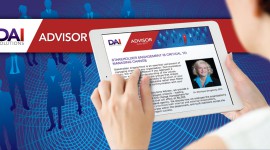13 Jun
2017
CASE STUDY: ENGAGING STAKEHOLDERS IN COMPLEX ORGANIZATIONS
Bruce Hall
97
change leadership and management
,
Charmaine Smith
,
communications
,
human capital strategy
,
program effectiveness
0 Comments
By Charmaine Smith
DAI Solutions supports a large, diverse federal agency with its transformation investment that will result in improved business operations and decision tools for leadership.
Background
The agency is implementing an enterprise-wide human resources IT (HRIT) system that provides core HR processing, workforce management, and timekeeping capabilities. When live, the system will cover 80,000+ employees geographically dispersed across the United States and abroad.
Stakeholder Engagement Strategy
 DAI Solutions developed a customized four-pronged approach to shape meaningful relationships with internal and external stakeholders, build coalitions across the organization, and promote long lasting partnerships. The four phases are: (1) research and planning, (2) design and development, (3) implementation, and (4) evaluation.
DAI Solutions developed a customized four-pronged approach to shape meaningful relationships with internal and external stakeholders, build coalitions across the organization, and promote long lasting partnerships. The four phases are: (1) research and planning, (2) design and development, (3) implementation, and (4) evaluation.
Research and Planning
We began our engagement by conducting an organization-wide stakeholder assessment where we identified, segmented, and prioritized relevant stakeholders; including executive staff, governance bodies, functional directors, change agents, end users, and external stakeholders. We also made it a priority to understand the organization’s context and culture — we worked to learn the organizational structure, identified issues and pain points of stakeholders at every level, and determined communication needs, objectives, and determined measures of success.
Design and Development
Leveraging the information we gathered during the research and planning phase, and keeping in mind organizational complexities, we then collaborated with the agency’s leadership to gain buy-in on an execution strategy that ultimately provided the program a foundation for transformation. Together, we determined engagement activities for each phase of system implementation and determined messaging tailored to address the communication needs of each target audience.
Implementation
Because the system will affect every employee and cut across all functional areas, we built an interactive, cross-functional team comprised of change leaders committed to the success of the implementation and the benefits it brings to the organization. Additionally, we implemented a concept of operations for engagement — a process for ensuring effective communications between the program management office (PMO) and stakeholders, providing clear communication structure internally and externally, streamlining messaging, and upholding our principles of timeliness, accuracy, consistency, and transparency.
To support the execution of the concept of operations, we built defined roles and responsibilities:
- Program representative: one primary and alternate representative from each sub-organization serve as the main points of contact between the PMO and key stakeholders, and are accountable for all readiness and implementation activities for their groups
- Deployment coordinator: a member of the stakeholder engagement team works collaboratively with program representatives to support readiness activities, disseminate communications, and provide program updates to these sub-organization touch points. They also provide status updates of sub-organization readiness activities and mitigate issues as they arise
Program representatives and deployment coordinators bring subject matter experts, critical partners, and employees together to participate in readiness activities, and form working groups where work products are developed to support implementation.
Evaluation
We monitor stakeholder reach for all engagement activities, including electronically published program updates, ad hoc communication, teleconferences, webinars, and face-to-face engagement sessions, in a program engagement book. We also evaluate the impacts of our engagement by soliciting stakeholder feedback through various online surveys, and feedback cards, and share the gathered feedback with appropriate stakeholders through after action reports.
Path Forward
As we progress through system design, DAI Solutions will tailor engagement activities to align with the organization’s business needs, reassessing its stakeholders and communications objectives and designing a customized way forward plan — prioritizing the people part of transformation.





